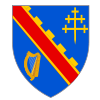Peatlands Park
Peatlands Park is a 266 hectares area established in 1990 and placed under the safeguard of the Northern Ireland Environment Agency.[1] It is located in County Armagh, Northern Ireland, and has been designated as an Area of Special Scientific Interest (ASSI).[2] Peatlands Park is home to a particularly rich sample of the fauna and flora found in peat bogs, and proposes 16 km (10 mi) of paths to its visitors.[3]
The park holds two natural reserves predating the park itself, Annagarriff (77 ha) and Mullenakill (22ha), established in 1980.[4] Of the two, Annagarriff is thought to be home to the only colony of Scottish wood ants in Ireland.[5]
It also holds a 3 ft (914 mm) narrow gauge railway established in 1901 and displays an outdoor turf cutting site.[6][7]

References
- ^ "Peatlands". Peatlands NI. Archived from the original on 2 October 2010. Retrieved 14 August 2010.
- ^ "Peatlands Park ASSI". NI Environment Agency. Retrieved 14 August 2010.[permanent dead link]
- ^ "Head to Peatlands Park for Perfect Day Out". NI Environment Agency. 29 July 2016. Retrieved 12 January 2019.
- ^ "Peatlands Park". Discover Northern Ireland. Retrieved 14 August 2010.
- ^ "Formica aquilonia – Scottish Wood Ant". Habitas - NI Priority Species. Retrieved 14 August 2010.
- ^ "Small industrial railways". Armagh County Museum. Archived from the original on 9 August 2010. Retrieved 14 August 2010.
- ^ "The Railway" (PDF). NI Environment Agency. Retrieved 14 August 2010.[permanent dead link]
External links
"Churchill - Home of the Verners". Craigavon Historical Society. Retrieved 14 August 2010.
54°29′06″N 6°36′32″W / 54.485°N 6.609°W

